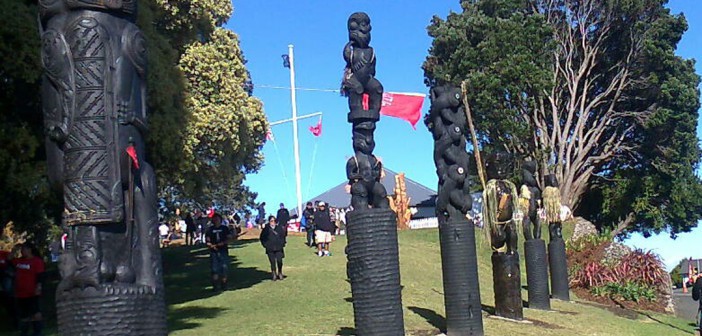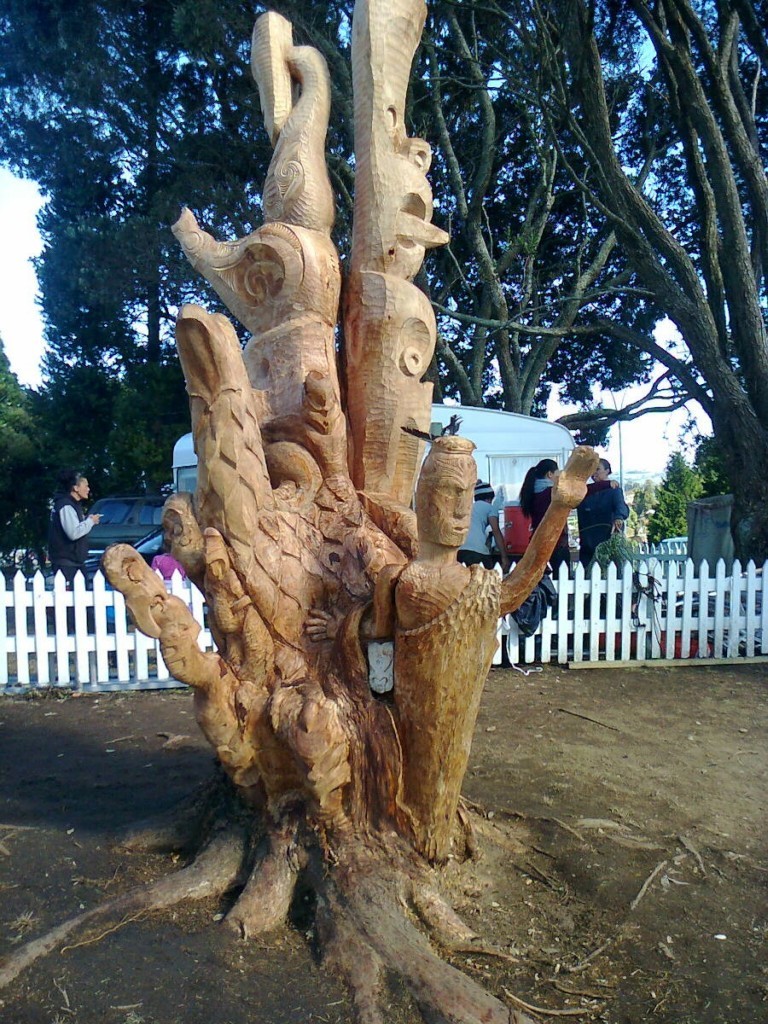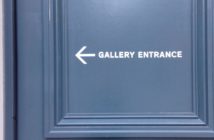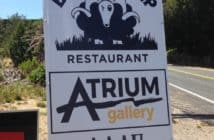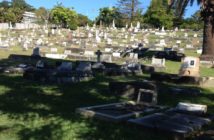Dawn Blessing of the Gate Pa Pou and Flagpole
I get up just after 4am. It’s dark. Outside it’s cold. It’s raining as I slide down the Whakamarama Road. There’s little traffic on SH2. Ahead at the Wairoa River,coming from Te Puna, is a people carrier followed by four or five cars moving as a convoy. I join its tail and we move through the mostly sleeping suburbs, past the road closed signs on Cameron Road. I don’t have a parking permit but the young man directs me to a nearby side road. With my ancient umbrella up I walk with the small groups towards the slickly black raincoated pouwhenua, this morning’s waiting warriors of Pukehinahina. Through the trees on the flat at the bottom of the reserve a brightly lit tent slashes the dark.
There is an increasing scrabble to remove the coverings of each pouwhenua as the tohunga and kaumatua speedily move up the slope of Pukehinahina blessing each individual pole and revealing the carving and detail in the dark and gloom. We move towards the flagpole by the lychgate of St George’s Church. The totara I’ve seen carved in the preceding week are blessed and the flags are raised. In the increasing light a a vibrant contemporary korowai of red and black feathers shelters the shoulders of a young woman. When we move off the platform she is standing next to me and I ask where she got her luminous cloak. The korowai was bought by her from the Maori Womens’ Welfare League at Waitangi, it is her taonga. The korowai is something to replace some of what was lost or confiscated. A group of young people hold a large board with the painted names of the Maori dead.

There are all sorts of people here – Councillors, Mayors, kaumatua and kuia, the young. I laugh as someone moments before traditionally dressed acknowledges me as he now walks by in gumboots and drizabone. I go down to the tent encircled flat lands. Even the tents record the wider tribal associations historically involved. In the Church Hall I look at the art awards. Tawhai Rickard has taken the major prize and Karen Frances Lawson the runner up adult award There are also sold signs on some of the works. I’m told one work by Ken Wright has been bought to donate to St George’s Church. I ask Puhiraki Ihaka what Rawiri Puhiraki would think of today. I tell Huikakahu Kawe how I appreciate the realism of “Aftermath”.
Outside the rain is falling in large bitterly cold drops as a blanket skirted warrior leads a war memorial rembrance service for fallen warriors. Holding the name board the lightly clad young people stand through the karakia honouring their war dead.
Today I notice the storyboards along the pathway through the reserve. There is a decorated container in the Church carpark for medical attention. Waiataha have attached a banner to their pouwhenua and are being photographed.
Military Memorial Service – Otamataha- Mission Cemetery, Tauranga.
On my way to the memorial service at the Otamataha Mission Cemetery I stop off at Alimento to drink hot chai and write up my notes. I think how it must have been at Pukehinahina, at Gallipoli and for my father in the Silesian mines and realise how easily we accept the good things.
I find a carpark within walking distance of the Cemetery but leave my car with the trepidation of any visitor to Tauranga, that it will be ticketed when I return. I walk across the bridge with Dan Murray. I talk to Designer, John Darke who is to recite a poem as part of the service. We stand outside the cemetry gate. Army band soldiers look as if they have just been unwrapped, their uniforms bright red and gold with panels of taneko embroidery. There’s a piper. I’m asked several times if I’ve seen the Bishop? I meet the parents of the young lieutenant on secondment to the New Zealand Navy who this morning will represent the Royal Navy.
We are called into the Cemetery. I stand behind a khaki army group, patent dress shoes more than spit gleaming. There are medals. The broadshouldered shape of Judge Joe Williams stands in front of me. The growling of truck and trailers gearing down pours through the pohutukawa a backdrop to a slow moving yacht mast. Whakariamai has never sounded so sad and wistful.
The representatives of religion remind me of Christmas tree decorations, their formal robes obscuring body shape. Something is said about how good it would have been if everyone could have just sat down, talked and resolved matters – I turn bemused to the young woman next to me. She laughs and says “150 years on you can say anything you like” I stand so the sun is on my face. The talking is done. Wreaths are laid. The last post is played. A plane skims the pohutukawas on its way to land. There are three loud firework bangs. The wind starts to blow the leaves from the trees and a leaf sits on Judge Joe’s shoulder. I check out the wreaths – one is yellow like the sun.
Oliver Burness-Smith, representing the Royal Navy, says his Granpa was in the RAF and his Father notes the Uncle who was in Vietnam. Joining the Navy was something Oliver always wanted to do. We have a laugh about the uniform and he tells me he’s here “to drive ships”. It’s clear he’ll remember being here. So will his parents who are so quietly proud of their child.
We walk on down to the morning tea at Trinity Wharf. Like everything else this morning, the organisation and the presentation is impeccable. I meet and talk. Around the walls traditionally black dressed kuia sit; a living memorial and breathing Goldies.
Kingitanga Powhiri
My car has not been ticketed or towed. I drive back to the Pukehinahina Reserve and surprisingly can park in the same area as previously. There’s a hubub of activity around the slopes behind the tented area. It’s a huge dressing room area whose occupants then fill the green courtyard created by the tents with the identifiable tino rangatira – Maori Sovereignty flag fluttering high above them. Some will be the direct descendants of those who fought in 1864.
I’m out on the roadway gathering for the formal entry. The Maori Wardens who are helping with crowd control have been on their feet since the early hours of the morning and by afternoon the cold and wet is having an effect. The Waikato Tainui contingent traditionally and teeshirtedly dressed flows around the whareroa (carved gateway) waiting for the arrival of King Tuhetia. A blackwindowed Landrover arrives out of which exit a group who move immediately in front of the gateway and it begins.
When the challenges start its a living Robley accompanied by shouts and taunts from the biggest gathering of warriors I have seen. These are not tourist garbed; the warriors as closely as possible wear the blankets, shirts, tophats, hairstyles and earing decoration of the period . A few carry muskets others traditional wooden stave spears. The background chanting makes their appearance even more intimidating. In front of this throng move a tall white and green korowai covered leader and a glowingly whitepainted figure – both in warfare terms easy targets. The challenge party move out towards the gateway and the traditional process takes it course of challenge and counterchallenge and acceptance of entry. As if to let the world know of the progress and change occuring within Maoridom, acontemporary besuited, battle axe wielding mature male, reminiscent of the waistcoatedSir Aprirana Ngata leading the haka, fronts the teeshirted Tainui representatives until his sweat glistens and he returns to the official party. The King and his officials are eventually ensconced in large chairs within their specially decorated marque.
The weather has changed completely and it’s sunny and hot. The crowd of onlookers has grown significantly since this morning, all the vantage points are four or five deep. There are children in the trees.
Commemoration March, Wero, Reconciliation Service and Ceremony
There’s a formal march along a section of Cameron Road led onto Pukehinahina by Sir Jerry Mataparai as Governor General and representative of the Crown in New Zealand. In the front line is a young girl holding someone’s hand. There are two soldiers in period dress. They are formally challenged by warriors who now represent the combined tribal groups who were at Pukehinahina. There is a wall of noise as staves are banged and chants are made. ( The next day I will see the same staves and challenge positions in the photographs in the Rotorua Museum of the Maori Battalion during World War II .)
Speeches start and flow back and forth. Mataparai states in clear and simple language why we are here – land, land for settlement, land acquisition and land confiscation. There is no wrapping the reason up even if the dispossessed have now moved to reconcilliation and forgiveness.
As people move around the site I meet an old work colleague, a soldier returned from Afghanistan , the Principal of a kura kaupapa, a young woman of Maori descent resident in the UK and her father and I’m asked by two media representatives for my impressions of the day. As I’m gathering impressions I ask the returned soldier next to me to give his impressions.
It’s past 4pm now, the cold autumn early evening chill has come on. Warriors start to move past me on their way home – the fearsome leader of the challenge party (now accompanied by his partner) his facial decoration so frightening from a distance is only simple stripes of colour as he walks by carrying his performance gear. I want to stay to hear the Chief Maori Land Court Judge, Joe Williams speak but I’ve had a long day and my booted feet require me to go home. It’s been one of the most memorable commemorative events I have ever attended.
Note: This event was attended by a number of media representatives and extensive images have been published and are available to view through sites such as Te , Sunlive, The Bay of Plenty Times and The Kete, Tauranga Memories Gate Pa.


